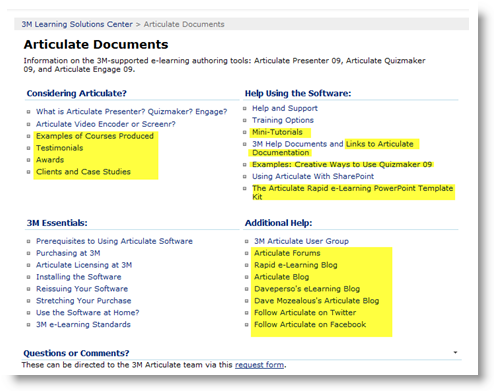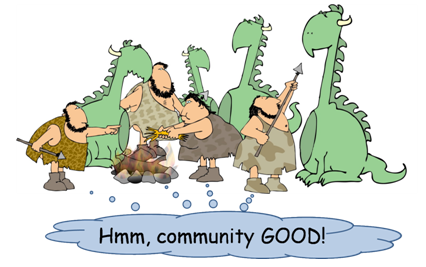Come Out of the Caves & Bring Fire to Your E-Learning Community
This guest blog entry was written by Articulate MVP Gerry Wasiluk. He is Learning Solutions Manager for HR Talent Solutions at 3M.
If your organization has a decentralized training structure, it can feel like working in a cave. A few groups may provide core services, like running the learning management system. But, like separate tribes, multiple learning operations serve learners in specific departments, functions, or locations.
As a result, you have many e-learning developers from many parts of the company, and their skills and experience can vary widely – from SMEs brand-new to e-learning, to seasoned developers. Often, these developers are building many e-learning courses, separate from each other.
Sounds a little prehistoric, doesn’t it?

Light the Fires for Success
At 3M, I manage our internal LMS and e-learning services from HR. To really light the fires for success in a decentralized environment, it’s important to build your e-learning developer community by getting folks out of their caves. You want them to interact with other developers, both inside and outside the organization.
Yes, building community takes work, and you may have more immediate demands than a caveman with a broken spear facing a horde of rampaging T-Rexes. But you’re not helpless and alone.

9 Ways to Build Your Organization’s Articulate User Community
Here are nine key things we do at 3M to encourage our developers and provide resources. We’re still in the primitive stages with this, and far from perfect, but we continue to evolve in the way we encourage our Articulate users.
- Let developers know you care about their success. Don’t leave developers with just the Articulate software and walk away. Great resources exist to help them build great e-learning, but often people need a little encouragement and direction. Be proactive in reaching out with tools and information – don’t wait to be asked.
- Build on Articulate’s community resources. No need to re-invent the proverbial wheel. Encourage folks to take advantage of the Articulate community. For example, Articulate already has a tremendous community forum—why should we create another? One day we might add things like internal blogs or wikis—but only to cover issues unique to our company or IT environment. We would always dovetail our resources with what Articulate already provides.
- Provide a central resource point. Don’t assume developers will bookmark or remember the available resources. Provide a central place where they can access what they need. We maintain a support site in SharePoint for our Articulate users. Here’s a peek at our opening page – I’ve highlighted in yellow all the features that link to Articulate’s resources:

If you do this, make sure to keep things updated. If Articulate changes or adds resources, it’s important to stay on top of that. But that’s far easier than creating the needed resources yourself.
- Consider the Platinum Membership Plan. We have developers purchase Articulate’s Platinum Membership Plan when buying the software. We do this partly for survival. We have well over 100 folks using various Articulate software tools at 3M, but there are mainly only two of us supporting them—and it’s just a very small part of our jobs. But, more importantly, with Platinum Membership our folks can easily and quickly get help from Articulate with their software questions and issues. This frees us up to concentrate on needs unique to our company and IT environment. It gives us more time to build community and provide resources. It’s a win-win for everyone.
We also encourage developers to leverage the Articulate community forums or connect with other developers within the company for e-learning ideas and advice. It’s a great way to encourage both self-sufficiency and community.
- Hold regular meetings. We hold regular webinars with developers as the 3M Articulate Users Group. We present both beginning and advanced topics, such as:
- The basics, including where to find helpful resources,
- Current challenges developers are experiencing,
- New corporate resources that may help (such as 3M’s new streaming video services)
- Great tips and techniques from Articulate’s forums or Screenr tutorials, and
- Samples from actual courses that show best practices or techniques.
For now, my colleague and I usually do most of the presenting, but we want to do more to encourage developers to present to our user group. That sharing helps build community.
We record our webinars and make them available for review after. All developers receive the playback links and slides. This is critical with busy schedules and developers in many time zones.
If you have a central group of co-located developers, face-to-face meetings are wonderful, too! Do simple things like get together regularly over lunch to share, network, and even review each other’s work. Social media and other electronic resources are also helpful, but never forget the power of face-to-face.
- Have one or more staff actively participate in the Articulate community forums and collect helpful resources. Make it part of their jobs. And make sure they spread the learning. If you have a “scout on the horizon,” that person can be out there hunting for good ideas and best practices, and then share with the rest of the pack.

- Communicate. We send out periodic e-mails on important news and issues developers need to know—things that cannot wait for a webinar. For example, we might share important software or LMS-related issues that folks need to know about now. We also keep users informed of new services, or changes in our operations that affect e-learning, or even important Articulate news, like when a new software version or resource is released.
- Build a contact list of developers and keep it current. We use Lotus Notes for our internal email, and we’ve got e-mail groups set up for our e-learning developers. This allows us to easily reach out to developers any time. Don’t be afraid to encourage developers to use the list to share information, too. Encourage a culture of sharing.
- Don’t discourage independent efforts. If you’re the one spearheading the use of Articulate tools in your organization, don’t feel that everything has to go through you or that you have to “own everything.” Let others step up and lead and share. Or find a way for them to help you with what you cannot do. You can show leadership by encouraging integration of cross-functional efforts to fill gaps and reduce redundant work.
Leave the Prehistoric Era
These are just a few things that we do. The list isn’t exhaustive. We’re just beginning to light the fires of success. But I hope these ideas inspire you to build your resources and your developer community. Connecting your internal developers to each other and to the larger Articulate community is a great way to help ensure e-learning success. Just keep your mind open to new ideas and new ways to reach folks. You don’t have to know it all or do it all.
Time to leave the prehistoric era. Get your folks out of their caves.

2 responses to “Come Out of the Caves & Bring Fire to Your E-Learning Community”
Good ideas. My company is a not-for-profit so it’s hard to come by money for development opportunities. We’ve been talking about starting an Articulate Users Group so this is very timely.
[…] 3M user group and turned it into a helpful resource for the whole Articulate community by authoring a popular Word Of Mouth blog post on how to build effective internal communities of […]
Comments are closed on this post. Need more help? Post your question in the E-Learning Heroes Discussions.